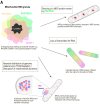RNA Granules in the Mitochondria and Their Organization under Mitochondrial Stresses
- PMID: 34502411
- PMCID: PMC8431320
- DOI: 10.3390/ijms22179502
RNA Granules in the Mitochondria and Their Organization under Mitochondrial Stresses
Abstract
The human mitochondrial genome (mtDNA) regulates its transcription products in specialised and distinct ways as compared to nuclear transcription. Thanks to its mtDNA mitochondria possess their own set of tRNAs, rRNAs and mRNAs that encode a subset of the protein subunits of the electron transport chain complexes. The RNA regulation within mitochondria is organised within specialised, membraneless, compartments of RNA-protein complexes, called the Mitochondrial RNA Granules (MRGs). MRGs were first identified to contain nascent mRNA, complexed with many proteins involved in RNA processing and maturation and ribosome assembly. Most recently, double-stranded RNA (dsRNA) species, a hybrid of the two complementary mRNA strands, were found to form granules in the matrix of mitochondria. These RNA granules are therefore components of the mitochondrial post-transcriptional pathway and as such play an essential role in mitochondrial gene expression. Mitochondrial dysfunctions in the form of, for example, RNA processing or RNA quality control defects, or inhibition of mitochondrial fission, can cause the loss or the aberrant accumulation of these RNA granules. These findings underline the important link between mitochondrial maintenance and the efficient expression of its genome.
Keywords: RNA degradation; RNA processing; degradosome; dsRNA; liquid–liquid phase separation (LLPS); mitochondrial RNA granules (MRGs); mitochondrial gene expression; nucleoids.
Conflict of interest statement
The authors declare no conflict of interest.
Figures



References
Publication types
MeSH terms
Substances
Grants and funding
LinkOut - more resources
Full Text Sources

